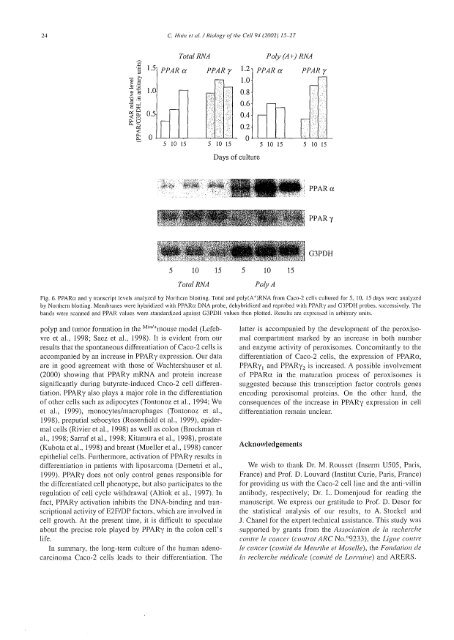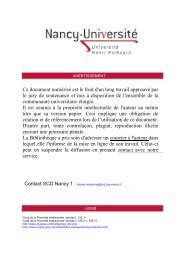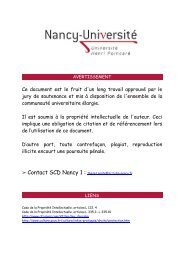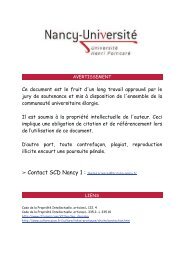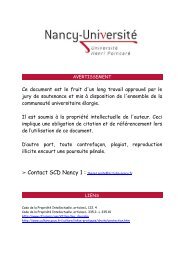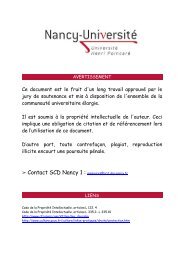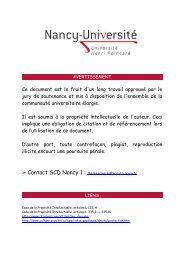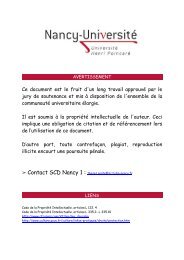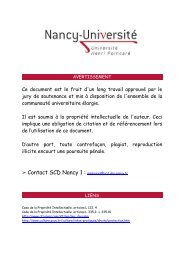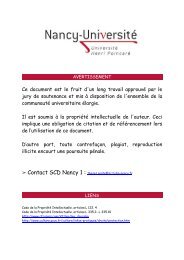Ce document numérisé est le fruit d'un long travail approuvé par le ...
Ce document numérisé est le fruit d'un long travail approuvé par le ...
Ce document numérisé est le fruit d'un long travail approuvé par le ...
You also want an ePaper? Increase the reach of your titles
YUMPU automatically turns print PDFs into web optimized ePapers that Google loves.
24 C. Huill el a/. / Biology oflhe <strong>Ce</strong>1l94 (2002) 15-27<br />
Total RNA<br />
1.5 PPAR a PPARy<br />
1.2<br />
1.0<br />
0.8<br />
0.6<br />
0.4<br />
Poly (A+) RNA<br />
PPAR a<br />
PPAR y<br />
0.2<br />
o.\--l--'-----L.,...-J-__---L:.:;....L-".L.:...e..L,<br />
Days of culture<br />
5 10 15<br />
5 10 15<br />
PPARa<br />
PPAR Y<br />
G3PDH<br />
5 10<br />
Total RNA<br />
15 5 10<br />
PolyA<br />
15<br />
Fig. 6. PPARa and y transcript <strong>le</strong>vels analyzed by Northern blotting. Total and poly(A+)RNA from Caco-2 cells cultured for 5, 10, 15 days were analyzed<br />
by Northern blotting. Membranes were hybridized with PPARa DNA probe, dehybridized and reprobed \Vith PPARy and G3PDH probes, successively. The<br />
bands \Vere scanned and PPAR values \Vere standardized against G3PDH values then plotted. Results are expressed in arbitrary units.<br />
polyp and tumor formation in the Min/+mouse model (Lefebvre<br />
et al., 1998; Saez et al., 1998). It is evident from our<br />
resu1ts that the spontaneous differentiation of Caco-2 cells is<br />
accompanied by an increase in PPARy expression. Our data<br />
are in good agreement with those of Wachtershauser et al.<br />
(2000) showing that PPARy mRNA and protein increase<br />
significant1y during butyrate-induced Caco-2 ceH differentiation.<br />
PPARy also plays a major ro1e in the differentiation<br />
of other ceHs such as adipocytes (Tontonoz et al., 1994; Wu<br />
et al., 1999), monocytes/macrophages (Tontonoz et al.,<br />
1998), preputia1 sebocytes (Rosenfie1d et al., 1999), epidermal<br />
cells (Rivier et al., 1998) as well as colon (Brockman et<br />
al., 1998; Sarraf et al., 1998; Kitamura et al., 1998), prostate<br />
(Kubota et al., 1998) and breast (MueHer et al., 1998) cancer<br />
epithelial cells. Furthermore, activation of PPARy results in<br />
differentiation in patients with 1iposarcoma (Demetri et al.,<br />
1999). PPARy does not only control genes responsib<strong>le</strong> for<br />
the differentiated cell phenotype, but a1so <strong>par</strong>ticipates to the<br />
regulation of cell cyc<strong>le</strong> withdrawa1 (Altiok et al., 1997). In<br />
fact, PPARy activation inhibits the DNA-binding and transcriptiona1<br />
activity of E2F/DP factors, which are invo1ved in<br />
cell growth. At the present time, it is difficult to speculate<br />
about the precise ro1e played by PPARy in the colon cell's<br />
life.<br />
In summary, the <strong>long</strong>-term culture of the human adenocarcinoma<br />
Caco-2 ceHs <strong>le</strong>ads to their differentiation. The<br />
latter is accompanied by the development of the peroxisomal<br />
com<strong>par</strong>tment marked by an increase in both number<br />
and enzyme activity of peroxisomes. Concomitantly to the<br />
differentiation of Caco-2 celIs, the expression of PPARa,<br />
PPARYI and PPARY2 is increased. A possib<strong>le</strong> involvement<br />
of PPARa in the maturation process of peroxisomes is<br />
sugg<strong>est</strong>ed because this transcription factor controis genes<br />
encoding peroxisomal proteins. On the other hand, the<br />
consequences of the inCl'ease in PPARy expression in cell<br />
differentiation remain unc<strong>le</strong>ar.<br />
Acknow<strong>le</strong>dgements<br />
We wish to thank Dr. M. Rousset (Inserm U505, Paris,<br />
France) and Prof. D. Louvard (Institut Curie, Paris, France)<br />
for providing us with the Caco-2 cell line and the anti-villin<br />
antibody, respectively; Dr. L. Domenjoud for reading the<br />
manuscript. We express our gratitude to Prof. D. Desor for<br />
the statistical analysis of our results, to A. Stoekel and<br />
1. Chanel for the expert technical assistance. This study was<br />
supported by grants from the Association de la recherche<br />
contre <strong>le</strong> cancer (contrat ARC No.o9233), the Ligue contre<br />
<strong>le</strong> cclllcer (comité de Meurthe et Mosel<strong>le</strong>), the Fondation de<br />
la recherche médica<strong>le</strong> (comité de Lorraine) and ARERS.


